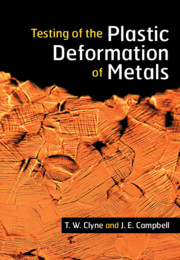Book contents
- Testing of the Plastic Deformation of Metals
- Reviews
- Testing of the Plastic Deformation of Metals
- Copyright page
- Contents
- Preface
- Nomenclature
- 1 General Introduction
- 2 Stresses, Strains and Elasticity
- 3 Continuum Plasticity
- 4 Mechanisms of Plastic Deformation in Metals
- 5 Tensile Testing
- 6 Compressive Testing
- 7 Hardness Testing
- 8 Indentation Plastometry
- 9 Nanoindentation and Micropillar Compression
- 10 Other Testing Geometries and Conditions
- Index
- References
4 - Mechanisms of Plastic Deformation in Metals
Published online by Cambridge University Press: 24 May 2021
- Testing of the Plastic Deformation of Metals
- Reviews
- Testing of the Plastic Deformation of Metals
- Copyright page
- Contents
- Preface
- Nomenclature
- 1 General Introduction
- 2 Stresses, Strains and Elasticity
- 3 Continuum Plasticity
- 4 Mechanisms of Plastic Deformation in Metals
- 5 Tensile Testing
- 6 Compressive Testing
- 7 Hardness Testing
- 8 Indentation Plastometry
- 9 Nanoindentation and Micropillar Compression
- 10 Other Testing Geometries and Conditions
- Index
- References
Summary
The capacity of metals to undergo large plastic strains (without fracturing) is one of their most important characteristics. It allows them to be formed into complex shapes. It also means that a component under mechanical load is likely to experience some (local) plasticity, rather than starting to crack or exhibit other kinds of damage that could impair its function. Metals are in general superior to other types of material in this respect. This has been known for millennia, but the reasons behind it, and the mechanisms involved in metal plasticity, only started to become clear less than a century ago and have been understood in real depth for just a few decades. Central to this understanding is the atomic scale structure of dislocations, and the ways in which they can move so as to cause plastic deformation, although there are also several other plasticity mechanisms that can be activated under certain circumstances. These are described in this chapter, together with information about how they tend to be affected by the metal microstructure. This term encompasses a complex range of features, including crystal structure, grain size, texture, alloying additions, impurities, phase constitution etc.
Keywords
- Type
- Chapter
- Information
- Testing of the Plastic Deformation of Metals , pp. 43 - 80Publisher: Cambridge University PressPrint publication year: 2021
References
- 1
- Cited by



